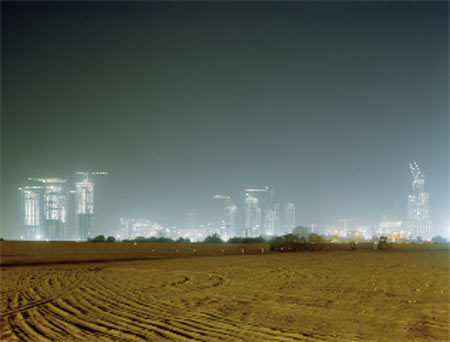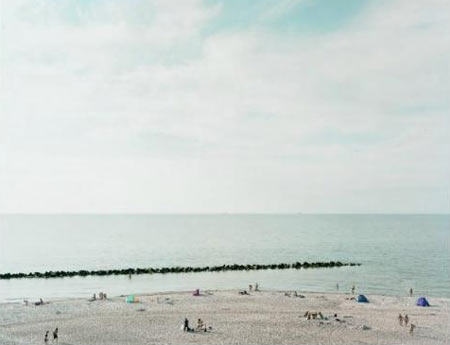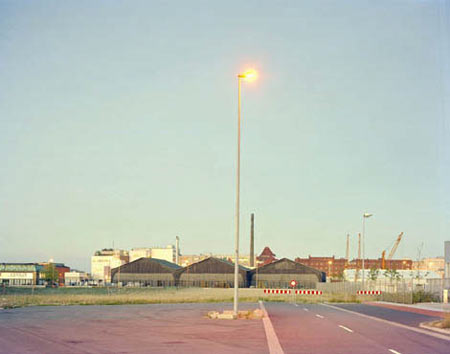A Conversation with Peter Bialobrzeski

After I found an article about blogs in a German photography magazine, I contacted its author, photographer Peter Bialobrzeski, to ask a couple questions about the German scene - and from there, it was almost a logical step to ask him for an interview. I was/am very happy about his willingness to participate, especially since there has been a lot of talk about German photography on this blog. So is bigger better? Is there a uniquely German style of photography? Let’s find out!

Jörg Colberg: Recently, the topic “plagiarism” has popped up quite frequently in the context of fine-art photography. For photographers, plagiarism is not that straight-forward to define as for, say writers. What we have seen is that there has been very little discussion amongst photographers about the topic, with matters usually only being settled in courts. So what exactly is plagiarism in photography? For example, if I was to take a photo of a building that is well known and has been photographed a lot where would plagiarism start?
Peter Bialobrzeski: That is really not an easy question. I don’t think it is a legal issue. There have been cases where photographers knew and studied the work of others, and photographed from exactly the same vantage points, printed the work in the same size, even used the same lab. There, one could say the work was modeled after someone else’s. Legally, of course, it might be still an independent photograph, but when you look at it as fine art, it simply does not work. I think to be really able to judge you need to know the story behind the image. For example, I found images of the same building, shot at night by Frank van der Salm, Martin Zeller and me in Hong Kong, independently of each other. It is quite an obvious thing to do, when you are into that kind of photography. I never used the picture in a fine-art context, but my agency is selling it as a stock photograph. Frank van der Salm has used it in a catalogue, and it is more precise then mine. Martin Zeller has tilted and shifted his night shot from a different vantage point. So when I know these pictures have been shown by other artists, I would not use mine in a book. It simply would not make any sense, and it would look stupid. Frank van der Salm also took a picture of a Hong Kong building, which is strikingly similar to one of Michael Wolf’s. What are we to we make of that?
People deeply involved in contemporary photography can almost sense which photo was modeled after what other photo, and people who get too close make a fool out of themselves anyway. But looking at the debate on the net, I find it quite frightening how many people, especially in large-format circles, are really into doing their Ansel Adams on and on….
JC: I guess the best way to both steer around plagiarism and to make an impact for a photographer is to find a new and interesting topic. You have been teaching photography for a while - what do you tell your students about how to find and approach new topics?
PB: There is nothing entirely new, especially when people are learning. I try to find out what the student’s creative DNA looks like. Is she or he more emotional or analytical? For me, it is important that the work has some contemporary connotation, that it is related to topics which are currently being discussed and are most important. And when my students are close to getting their diplomas, I check that they reach a point where they think they can’t do better than this. That’s a good way to test out their abilities. We discuss other photographers` work a lot, we invite other photographers or students I come across. It is important to know what is going on. But sometimes it is also very frustrating for them to see that everything seems to have been done before. We had some very good graduates recently. Christian Wolter just scored a book deal with his project Blühende Landschaften. We did a month long documentary in Calcutta with twenty students, which GEO magazine is going to publish, and we are also preparing a book and an exhibition that will be shown in Germany and India.

JC: Having lived in the US for quite a while now and having been active on the internet, I often come across statements of some sort of German school of photography, something that is distinct from what, say, is being done here in the US. From your perspective as a German photographer and educator what is your take on this? Is there a German way to look at things and if so, how does it translate into photography?
PB: Yes, clearly, there is. A lot of photography that came out of the universities in Germany in the late nineties was very sober and distant, while a lot of international stuff was more emotional. Difficult to imagine a German Michael Ackerman or Antoine d’Agata.
Maybe it has to do with the success of the Düsseldorf School. But maybe it is also an attempt by young photographers to make their work and themselves distinct from advertising and editorial work, which by the nature of things always has been more visually seductive. Maybe it is a bit dangerous to relate the aesthetics to some kind of German mentality. Recently, I have seen older work by Thomas Hoeker and Dirk Reinartz, and it is amazing how their street photography relates to either Frank, Winogrand, or Klein. Maybe it is just obvious for younger photographers to relate to their heroes, which are less explorative. Well, and really, if you look at the environment people live in, it is scary, ugly, made of concrete, so the desire to picture this is understandable. For me, the whole soberness seemed a bit ‘bemüht’ [forced] and also pitiless. I prefer Joel Sternfeld’s approach above all. He simply looks for some beauty in the absurd, like in American Prospects, which is not exactly celebrating America, but it leaves you some breathing space. Sternfeld cares.
I think now things are changing, because in the early 2000s that kind of cooler aesthetics was picked up by fashion, advertising, and editorial photography. So these days, work is getting more emotional, more playful again. Well, I hope so. I mean in Holland and Finland in some cases the work does not look so different, even though intellectually it is quite often more sophisticated than in Germany. Which really takes us to the answer to your next question.

JC: In an article in a German photography magazine you talked about how the German photography scene had almost no equivalent of the lively blog scene that can be found in the US and in other countries. Given that there is so much cutting-edge photography coming out of Germany why is that? And what can be done to change it?
PB: I do think that the German educational system does not encourage people to think enough. So whenever I go to London or New York, at dinner parties I experience a much more lively intellectual debate than back home, whether it is about photography, literature, or music. Everybody seems to have a passion for something and is willing to debate it. Here, and this is just personal experience, people tend to be just opinionated, while not really justifying or really arguing their case. It’s more like: I don’t like it. Full stop. A lot of photographers also never learned to speak about their work in a way that is not art-historian/curator-speak. On the other hand, German photography schools or art departments used to leave their students a lot of time to explore, to make mistakes. Education was free, even when you spent 16 semesters at art school. Of course, people who really work hard during their 6 or 7 years at college will be a bit older, a bit more reflective, and of course their portfolios have to be a bit more sophisticated than a British art student’s, aged 21, with a B.A. in photography. So we will see what happens in the future. In 2008/9 almost all photography schools will have turned to the BA/MA system, which will shorten the average time spent at the university. One can’t really say, whether this is a good or bad thing, in the end it depends on the individual.
Coming back to the blogging debate, from my perspective there is not enough critical debate in the education system, simply because it is dangerous for teachers and professors to communicate a real position and an attitude. Where I teach, everything is nice and possible, and in my class I try to be different, because I really think the only thing you can teach is to develop a critical distance towards your own work, to become your own hardest critic.
JC: So how could the German system be changed to make it more open? Changing degrees and study times over to an Anglo-American system is obviously not going to achieve that if the way things are being taught remains the same. What can be done?
PB: In arts education it is very important that people also read literature. But where do you start? Just yesterday a survey was published that showed that 42% of German students aged 14-19 never touch a book. So the problem really goes back to primary education. In an ideal world, a practical photography class would always interact with cultural sciences and popular culture. It is also important to actually teach writing. In good journalism, like in Ryszard Kapuscinski’s or Gay Talese’s, you find the same precision and attitude as in, say, Mitch Epstein’s or Larry Sultan’s photographs. It is really about creating an environment of intellectual debate. But a lot of German teachers are either too deep into their own research field or, worse, a lot of them don’t really have the ability to communicate that. Within the existing system of state-run institutions, I don’t see very much hope right now. One would need a very good network inside the system of education politics, a photography institution happy to cooperate, a very strict selection committee, and students willing to pay a tuition for a good education… That still would not guarantee great photographers to emerge, but people would have more fun and a better foundations for their careers.

JC: Let me also ask you about your own work. Where do you look for inspiration what to cover? And since you already mentioned Joel Sternfeld, are there other photographers who inspire you?
PB: It might sound strange when you look at my current work, but real eye openers for me were Gilles Peress’s Telex: Iran and Alex Webb’s “Under a grudging sun”. Both books were at the time incredibly fresh in form, but in a way they also constructed their essays. There is a lot of intelligence behind them, which is what I appreciate. So as a result I spend a lot of time on how I sequence my books, so that there is some kind of natural flow, which takes you through the subject and maybe lets you understand my motivation. Just through the images. In an ideal world, the text opens up another window. I look at lots of things, so inspirations always come from a mixture of personal experience and things you see in art, in the media. But even a sentence out of “Grey’s Anatomy” might strike a chord, which leads to a thought, that then leads to a note, which might turn into a project five years later. For me, the individual picture is not too important, I am interested in doing books. I am advocating photography as a cultural practice, not so much as fine art.
I think the hype around Gursky’s Munich show went over the top. In most cases, the prints are far too big, and the audience talks about the show as if it was a Van Gogh show. The pictures of the Formula 1 series are becoming the sunflowers of the late 2000s. You walk through that show, impressed, but you develop a craving for 100 small fiber prints by Gary Winogrand of his “1968” series. Talking about inspiration, I remember Gursky’s 1993 Deichtorhallen show in Hamburg, which was deeply inspiring for me. Looking at “Salerno” in the original size, the analogue print, not the digital spinoff they printed for Munich, was a revelation. Especially, because in a small cabinet next to it they were showing Cartier-Bresson. Which also was beautiful, but seeing the large Gurskys made HCB’s pictures look pretty dated.
JC: It sounds like you’re not the biggest fan of big prints then? Over the past few years, bigger appeared to be taken as just better, but I personally have some pretty big reservations about it. What is your take on this issue? And how would one determine the right print size?
PB: There are no rules. Of course, in order to look at Gursky the right way, you need a certain size, and if you show contemporary work in a museum, of course it is difficult to fight the space. I like a certain intimacy, where the picture as an object does not become too important. For my work, it felt right to print sizes between 95x120cm [37x47in] up to 120x160cm [47x63in]. I am just finishing my new book “Lost in Transition”, which will be published by HatjeCantz in the Fall, and I am experimenting with a white border around the images, and actual image sizes not larger then 90x120cm [35x47in]. It is just right. The students just printed their Kolkata Project 70x90cm [27x35in], and it is just beautiful. You can view some pictures here. The “making of” is documented here.
Another size experience I had at a recent opening of a very commercial Elliot Erwitt show. They had printed his greatest hits as laser prints, large size, selling for some obscene amount of money. In one corner there were some forgotten, unimportant fiber-based work prints sized 18x24cm [7x9in], or even smaller. I had never seen those pictures, they had a kind of innocent beauty, some beautiful tone was around them. And of course, 30 to 40 years ago, Erwitt was never thinking bigger than a possible double-page spread, so printing suddenly so large feels as unhealthy as supersizing your Big Mac. With Gursky it is of course different: When he starts to think about an image it is the equivalent of a supersized seven course meal. Which is nice once in a while, but if you have too much of it, you might feel a bit stuffedÂ…

JC: And lastly, if you had to pick a single photograph to bring to the deserted island (along with the usual other stuff that people always ask about) which one would that be and why?
PB: Can I take books?
JC: Oh sure. So if you had to pick just one photo book which one would that be?
 By
By